How to spot scams like "Your system is heavily damaged by Two viruses"
Mac VirusAlso Known As: "Your system is heavily damaged by Two viruses!" pop-up
Get free scan and check if your device is infected.
Remove it nowTo use full-featured product, you have to purchase a license for Combo Cleaner. Seven days free trial available. Combo Cleaner is owned and operated by RCS LT, the parent company of PCRisk.com.
What kind of scam is "Your system is heavily damaged by Two viruses!"?
"Your system is heavily damaged by Two viruses!" is a scam run on deceptive websites (e.g. todaystrends[.]co, greacore[.]com, contentfilled[.]com, nbvtread[.]com and topoffert[.]com). There are multiple variants of this scam. The text presented in them is practically identical, however, the versions are visually different (e.g. layouts, fonts, graphical elements, etc.).
In general, "Your system is heavily damaged by Two viruses!" claims that users' Apple iPhones have been infected and consequently damaged. To prevent further damage, they are encouraged to download/install the promoted application.
Scams of this type make bogus claims in order to proliferate dubious products such as fake anti-virus tools, adware, browser hijackers and other uwnanted apps. These schemes often endorse Trojans, ransomware and other malware.
Typically, visitors to deceptive sites do not access them intentionally - most are redirected to them by intrusive ads or certain kind of applications.
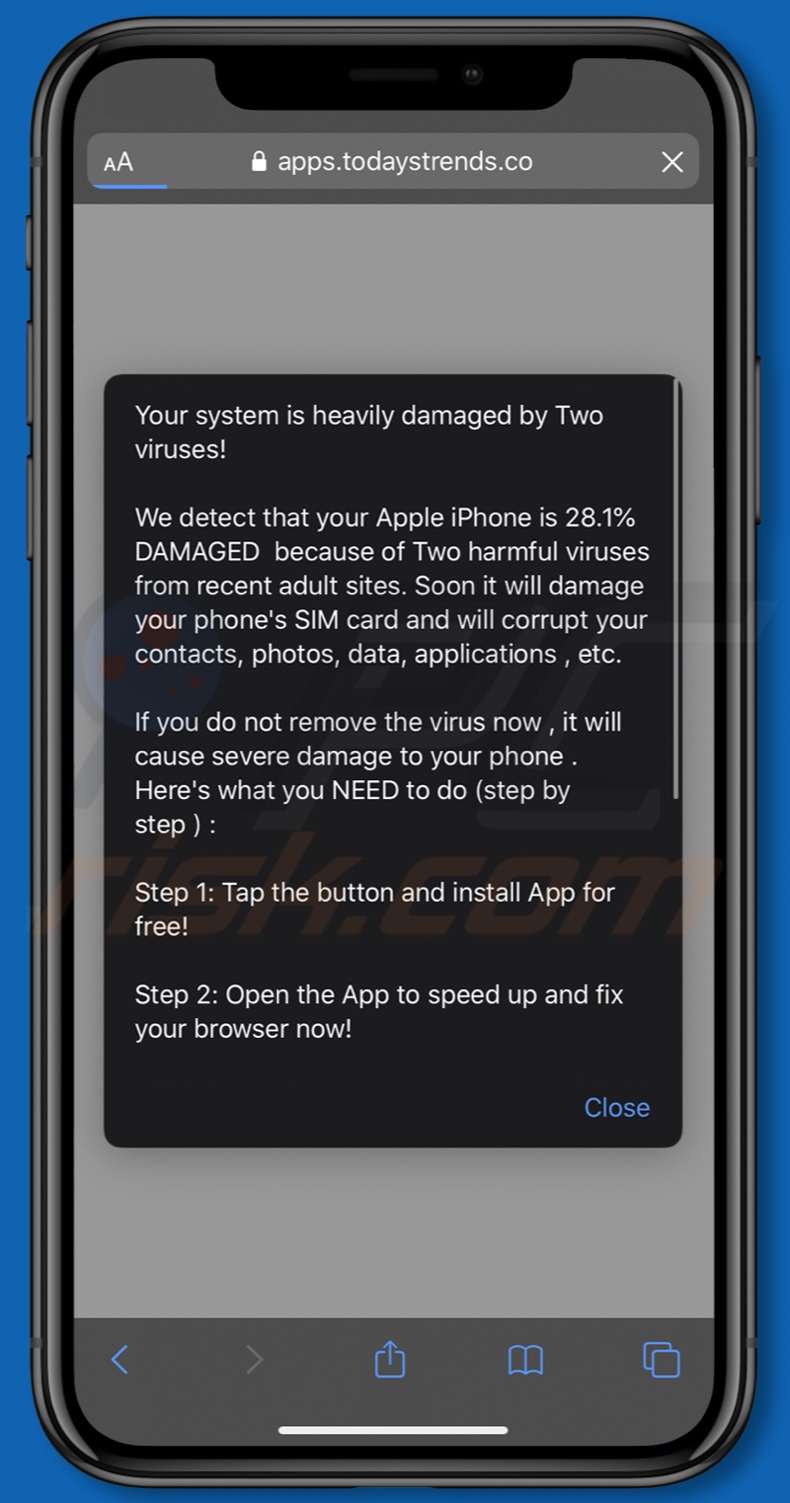
More about the "Your system is heavily damaged by Two viruses!" scam
"Your system is heavily damaged by Two viruses!" informs users that two viruses have been detected on their device - this claim is deceptive, as no website can detect threats/issues. The affected Apple iPhone has supposedly suffered 28.1% damage. According to the scam, the fake infections originated from recently-visited sites, which host adult content.
Additionally, it is stated that the viruses will soon corrupt the SIM card, thereby damaging the users' contact lists, photographs, applications and other data. To avoid this, users are encouraged to download/install the recommended app. Following these instructions can result in financial loss, system infections, serious privacy issues and even identity theft.
Therefore, you are strongly advised against trusting "Your system is heavily damaged by Two viruses!" and similar scams. Apps promoting such scams may seem legitimate and useful. Users are often enticed into download/installation with offers of various functionality, which does not work: it is merely bait to ensure the software's successful distribution.
To elaborate, fake anti-virus tools usually require activation (i.e. purchase) to perform the promised features, yet following activation, they remain nonoperational. These unwanted apps can have dangerous capabilities as well. They can force-open untrustworthy, deceptive and even malicious web pages.
More about unwanted applications
Adware-types deliver intrusive advertisements that diminish the browsing experience, promote dangerous sites and likewise harmful software (e.g. by redirecting to promotional pages and/or by stealthily downloading/installing the rogue software). Browser hijackers modify browser settings in promotion of fake search engines.
The promoted web searching tools are rarely capable of providing unique results, and so they redirect to Yahoo, Bing, Google and other legitimate search engines.
Most PUAs have data tracking capabilities, which are employed to monitor users' browsing activity. Information of interest includes visited URLs, viewed web pages, searched queries, IP addresses, geolocations and other details (that often contain personally identifiable information).
The collected data is then shared with and/or sold to third parties (potentially, cyber criminals). To protect device and user safety, remove all suspicious applications and browser extensions/plug-ins immediately upon detection.
| Name | "Your system is heavily damaged by Two viruses!" pop-up |
| Threat Type | Phishing, Scam, Mac malware, Mac virus. |
| Fake Claim | Users' devices are infected and damaged, they must download an app to fix the damage. |
| Related Domains | todaystrends[.]co; greacore[.]com; contentfilled[.]com; nbvtread[.]com; topoffert[.]com, cutedatesnow.com, trfcbooost.com, arraghand-top[.]com, poewaslim[.]com |
| Promoted Unwanted Application | Various dubious and possibly harmful applications. |
| Symptoms | Your Mac becomes slower than normal, you see unwanted pop-up ads, you are redirected to dubious websites. |
| Distribution methods | Deceptive pop-up ads, free software installers (bundling), fake Flash Player installers, torrent file downloads. |
| Damage | Internet browser tracking (potential privacy issues), display of unwanted ads, redirects to dubious websites, loss of private information. |
| Malware Removal (Windows) |
To eliminate possible malware infections, scan your computer with legitimate antivirus software. Our security researchers recommend using Combo Cleaner. Download Combo CleanerTo use full-featured product, you have to purchase a license for Combo Cleaner. 7 days free trial available. Combo Cleaner is owned and operated by RCS LT, the parent company of PCRisk.com. |
Similar scams in general
"Your Apple iPhone is severely damaged by 19 viruses!", "Your iPhone Has Been Hacked" and "(3) Viruses has been detected" are some examples of other scams such as "Your system is heavily damaged by Two viruses!". The web is full of deceptive websites, which make various claims.
Popular models include (but are not limited to) warnings that the device is infected, alerts that software is outdated, prize giveaways and raffles, "unbelievable" offers and deals, etc. Regardless of what the scams claim, offer, request or demand, the purpose is identical: to generate revenue for the developers.
How did unwanted applications install on my computer?
These apps can have "official" promotional/sale sites, which are often promoted by deceptive/scam web pages. These applications are more commonly downloaded/installed with other products. This deceptive marketing technique of packing regular software with unwanted or malicious additions is called "bundling".
Rushing download/installation processes (e.g. ignoring terms, skipping steps, etc.) increases the risk of unintentionally allowing bundled content into the system. Intrusive advertisements proliferate unwanted apps as well. When clicked, the ads can execute scripts to make downloads/installs without users' permission.
How to avoid installation of unwanted applications
Software should be researched prior to download/installation and/or purchase. You are strongly advised to only download from official and verified channels.
Dubious download sources such as unofficial and free file-hosting (freeware) websites, Peer-to-Peer sharing networks (BitTorrent, eMule, Gnutella, etc.) and other third party downloaders can offer deceptive and/or bundled content and should be avoided. When downloading/installing, read the terms, study all available options, use the "Custom/Advanced" settings and opt-out of supplementary apps, tools, features, and so on.
Intrusive ads may seem normal, however, they can redirect to dubious sites (e.g. gambling, pornography, adult-dating, etc.). If you encounter these ads or redirects, check all devices and immediately remove any suspect applications and browser extensions/plug-ins.
If your computer is already infected with rogue apps, we recommend running a scan with Combo Cleaner Antivirus for Windows to automatically eliminate them.
Text presented in the "Your system is heavily damaged by Two viruses!" scam:
Your system is heavily damaged by Two viruses!
We detected that your Apple iPhone is 28.1% DAMAGED because of Two harmful viruses from recent adult sites. Soon it will damage your phone's SIM card and will corrupt your contacts, photos, data, applications , etc.
If you do not remove the virus now , it will cause severe damage to your phone .
Here's what you NEED to do (step by step ) :
Step 1: Tap the button and install App for free!
Step 2: Open the App to speed up and fix your browser now!
Appearance of the other "Your system is heavily damaged by Two viruses!" scam variants:
To enable pop-up blocking, fraudulent website warnings, and remove web browsing data in mobile Apple devices, follow these steps:
First, go to "Settings", and then scroll down to find and tap "Safari".
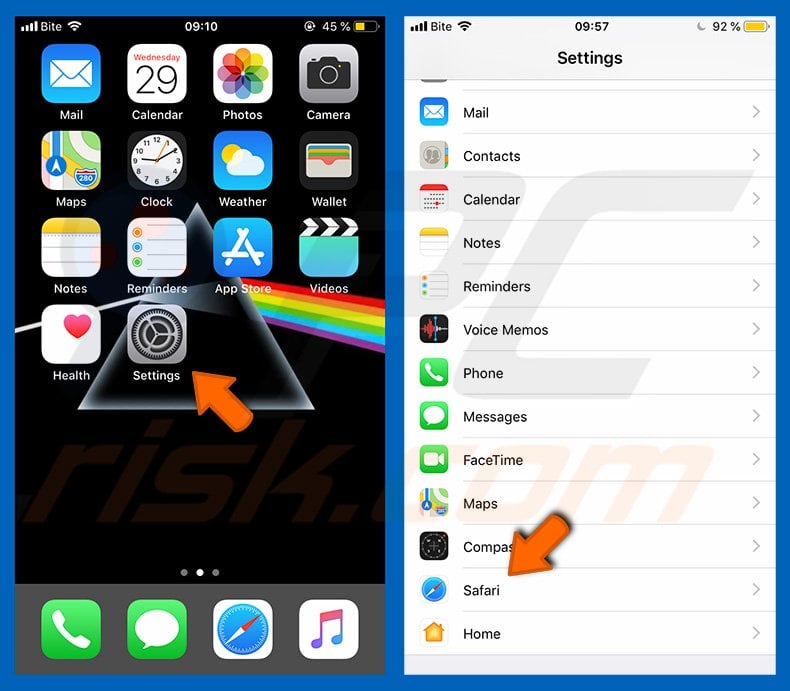
Check if the "Block Pop-ups" and "Fraudulent Website Warning" toggles are enabled. If not, enable them immediately. Then, scroll down and tap "Advanced".
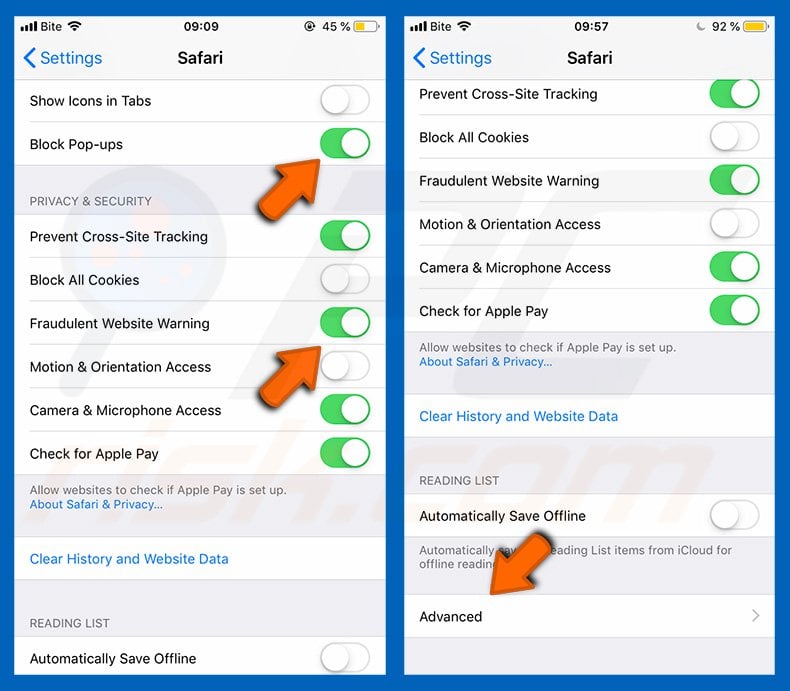
Tap "Website Data" and then "Remove All Website Data".
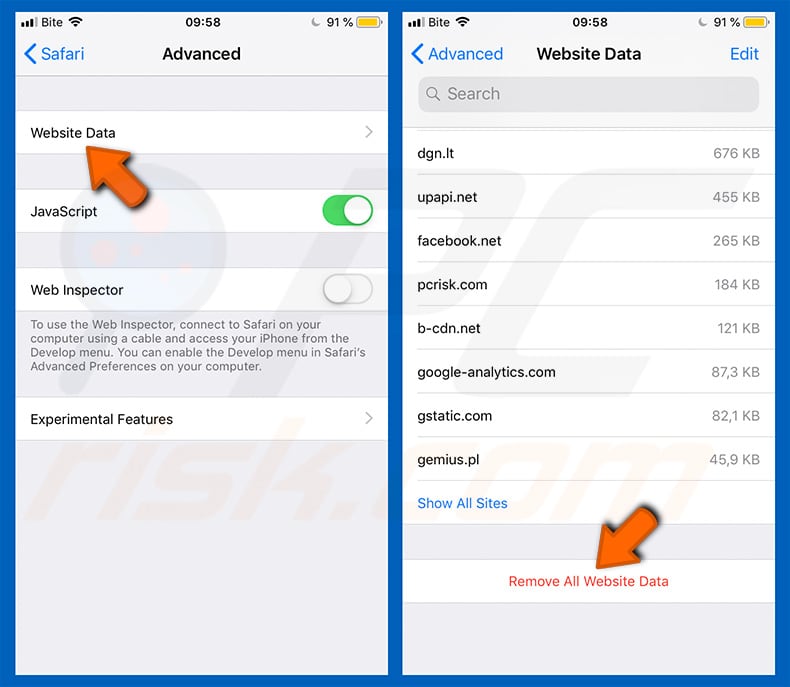
Instant automatic malware removal:
Manual threat removal might be a lengthy and complicated process that requires advanced IT skills. Combo Cleaner is a professional automatic malware removal tool that is recommended to get rid of malware. Download it by clicking the button below:
DOWNLOAD Combo CleanerBy downloading any software listed on this website you agree to our Privacy Policy and Terms of Use. To use full-featured product, you have to purchase a license for Combo Cleaner. 7 days free trial available. Combo Cleaner is owned and operated by RCS LT, the parent company of PCRisk.com.
Quick menu:
- What is "Your system is heavily damaged by Two viruses!"?
- STEP 1. Remove PUA related files and folders from OSX.
- STEP 2. Remove rogue extensions from Safari.
- STEP 3. Remove rogue add-ons from Google Chrome.
- STEP 4. Remove potentially unwanted plug-ins from Mozilla Firefox.
Video showing how to remove adware and browser hijackers from a Mac computer:
Potentially unwanted applications removal:
Remove potentially unwanted applications from your "Applications" folder:

Click the Finder icon. In the Finder window, select "Applications". In the applications folder, look for "MPlayerX","NicePlayer", or other suspicious applications and drag them to the Trash. After removing the potentially unwanted application(s) that cause online ads, scan your Mac for any remaining unwanted components.
DOWNLOAD remover for malware infections
Combo Cleaner checks if your computer is infected with malware. To use full-featured product, you have to purchase a license for Combo Cleaner. 7 days free trial available. Combo Cleaner is owned and operated by RCS LT, the parent company of PCRisk.com.
Remove adware-related files and folders

Click the Finder icon, from the menu bar. Choose Go, and click Go to Folder...
 Check for adware generated files in the /Library/LaunchAgents/ folder:
Check for adware generated files in the /Library/LaunchAgents/ folder:

In the Go to Folder... bar, type: /Library/LaunchAgents/

In the "LaunchAgents" folder, look for any recently-added suspicious files and move them to the Trash. Examples of files generated by adware - "installmac.AppRemoval.plist", "myppes.download.plist", "mykotlerino.ltvbit.plist", "kuklorest.update.plist", etc. Adware commonly installs several files with the exact same string.
 Check for adware generated files in the ~/Library/Application Support/ folder:
Check for adware generated files in the ~/Library/Application Support/ folder:

In the Go to Folder... bar, type: ~/Library/Application Support/

In the "Application Support" folder, look for any recently-added suspicious folders. For example, "MplayerX" or "NicePlayer", and move these folders to the Trash.
 Check for adware generated files in the ~/Library/LaunchAgents/ folder:
Check for adware generated files in the ~/Library/LaunchAgents/ folder:

In the Go to Folder... bar, type: ~/Library/LaunchAgents/

In the "LaunchAgents" folder, look for any recently-added suspicious files and move them to the Trash. Examples of files generated by adware - "installmac.AppRemoval.plist", "myppes.download.plist", "mykotlerino.ltvbit.plist", "kuklorest.update.plist", etc. Adware commonly installs several files with the exact same string.
 Check for adware generated files in the /Library/LaunchDaemons/ folder:
Check for adware generated files in the /Library/LaunchDaemons/ folder:

In the "Go to Folder..." bar, type: /Library/LaunchDaemons/

In the "LaunchDaemons" folder, look for recently-added suspicious files. For example "com.aoudad.net-preferences.plist", "com.myppes.net-preferences.plist", "com.kuklorest.net-preferences.plist", "com.avickUpd.plist", etc., and move them to the Trash.
 Scan your Mac with Combo Cleaner:
Scan your Mac with Combo Cleaner:
If you have followed all the steps correctly, your Mac should be clean of infections. To ensure your system is not infected, run a scan with Combo Cleaner Antivirus. Download it HERE. After downloading the file, double click combocleaner.dmg installer. In the opened window, drag and drop the Combo Cleaner icon on top of the Applications icon. Now open your launchpad and click on the Combo Cleaner icon. Wait until Combo Cleaner updates its virus definition database and click the "Start Combo Scan" button.

Combo Cleaner will scan your Mac for malware infections. If the antivirus scan displays "no threats found" - this means that you can continue with the removal guide; otherwise, it's recommended to remove any found infections before continuing.

After removing files and folders generated by the adware, continue to remove rogue extensions from your Internet browsers.
Remove malicious extensions from Internet browsers
 Remove malicious Safari extensions:
Remove malicious Safari extensions:

Open the Safari browser, from the menu bar, select "Safari" and click "Preferences...".

In the preferences window, select "Extensions" and look for any recently-installed suspicious extensions. When located, click the "Uninstall" button next to it/them. Note that you can safely uninstall all extensions from your Safari browser - none are crucial for regular browser operation.
- If you continue to have problems with browser redirects and unwanted advertisements - Reset Safari.
 Remove malicious extensions from Google Chrome:
Remove malicious extensions from Google Chrome:

Click the Chrome menu icon ![]() (at the top right corner of Google Chrome), select "More Tools" and click "Extensions". Locate all recently-installed suspicious extensions, select these entries and click "Remove".
(at the top right corner of Google Chrome), select "More Tools" and click "Extensions". Locate all recently-installed suspicious extensions, select these entries and click "Remove".

- If you continue to have problems with browser redirects and unwanted advertisements - Reset Google Chrome.
 Remove malicious extensions from Mozilla Firefox:
Remove malicious extensions from Mozilla Firefox:

Click the Firefox menu ![]() (at the top right corner of the main window) and select "Add-ons and themes". Click "Extensions", in the opened window locate all recently-installed suspicious extensions, click on the three dots and then click "Remove".
(at the top right corner of the main window) and select "Add-ons and themes". Click "Extensions", in the opened window locate all recently-installed suspicious extensions, click on the three dots and then click "Remove".

- If you continue to have problems with browser redirects and unwanted advertisements - Reset Mozilla Firefox.
Frequently Asked Questions (FAQ)
What is a pop-up scam?
It is a fake warning or other deceptive message designed to trick a website visitor into performing certain actions (e.g., downloading software, calling the provided number).
What is the purpose of a pop-up scam?
Typically, scammers behind pop-up scams aim to obtain sensitive information, steal identities, distribute malware, etc.
Why do I encounter fake pop-ups?
Usually, fake pop-ups are displayed by shady websites. These pages get opened via other websites that use rogue advertising networks, or installed adware (or other dubious software).
Will Combo Cleaner protect me from pop-up scams?
Combo Cleaner will scan all visited pages and detect the malicious ones (including pages that deliver pop-up scams). It will warn you immediately and restrict access to these pages.
Share:

Tomas Meskauskas
Expert security researcher, professional malware analyst
I am passionate about computer security and technology. I have an experience of over 10 years working in various companies related to computer technical issue solving and Internet security. I have been working as an author and editor for pcrisk.com since 2010. Follow me on Twitter and LinkedIn to stay informed about the latest online security threats.
PCrisk security portal is brought by a company RCS LT.
Joined forces of security researchers help educate computer users about the latest online security threats. More information about the company RCS LT.
Our malware removal guides are free. However, if you want to support us you can send us a donation.
DonatePCrisk security portal is brought by a company RCS LT.
Joined forces of security researchers help educate computer users about the latest online security threats. More information about the company RCS LT.
Our malware removal guides are free. However, if you want to support us you can send us a donation.
Donate
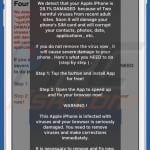
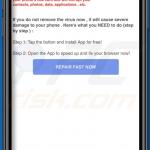
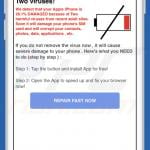
▼ Show Discussion